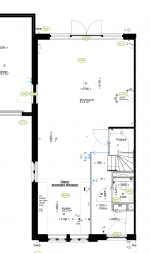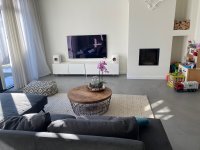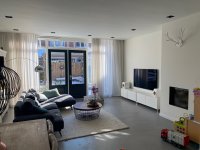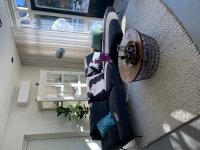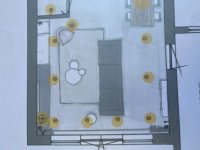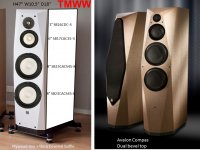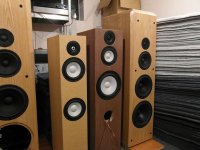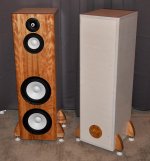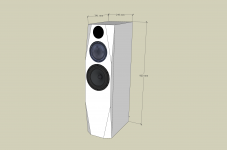Room details aren't important in this case. He has Kef LS50s. He isn't going to DIY anything that works better than those speakers. Those speakers are his reference. A loudspeaker that measures well -- like the Kef -- is going to work better in all rooms relative to speakers that don't.
He needs to get his Kefs working with his subs before he DIYs main channels.
He needs to get his Kefs working with his subs before he DIYs main channels.
As I understand the initial post, the KEFs are out of the picture. They are going to used elsewhere. And this is all about a brand new system for the living room.
How do you feel about using a waveguide?Tadaa said:The constraint is that they need to be placed close to the corners.
This is interesting. A multisub setup could be said to need doing regardless. Establishing a setup that is practical allows the lower portion of the spectrum to be crossed of the list, so to speak, which is a step in the right direction.bradleypnw said:He needs to get his Kefs working with his subs before he DIYs main channels.
It can't be easy to know what to ask at the start. Sometimes the question has to be specific, and sometimes broad.But like so many newbies here, they think they already know the answer without ever defining the problem.
Moving the Kefs to a desk is a little odd. That sounds to me like he thinks they're bad at low frequencies so he demoted them to a desktop system. He's definitely dealing with a modal problem caused by using a single 13" subwoofer. He might also be suffering a boundary problem with the Kefs. If he addresses those issues he'd be much better informed on how to approach DIYing main channels.
Hollowboy suggested getting a measurement microphone. Which I think is the best way to start.
Hollowboy suggested getting a measurement microphone. Which I think is the best way to start.
Getting a microphone is a very small part of what the needs to do. Apparently he hasn’t even read any books on speaker design, doesn’t have any analysis tools, and yet he plans on building a very high end, sophisticated speaker that most highly experienced designers would find challenging.
This is a typical newbie type post that occurs almost on a weekly basis. But if you suggest they start simpler instead with a good proven design by someone with real experience you are generally ignored.
This is a typical newbie type post that occurs almost on a weekly basis. But if you suggest they start simpler instead with a good proven design by someone with real experience you are generally ignored.
I see more people asked about the room.
The livingroom (with open kitchen) is L-shaped. On the first attatchemt you can see the floorplan (all the measurments are in MM). The wall to the garden is mainly of glass, great for light (and horrible for sound). We have a very thin curtain, just for a little bit of privacy.
On the photos, you can see that in the corner (close to the stairs) we have a fireplace. The area that is for the TV/speakers and cabinet are around 300/320 CM. The current white cabinet is 240cm. The speakers are like 230cm apart. I have tried stands before, but it didn't impact the sound a lot. This is also safer for our two years old boy.
My right LS50 is damaged since a month, but that is not the only issue I have. I will repair this one and reuse it (on my desk in my home office).
I'm sitting like 300/350cm away from the speakers. I have included a photo of the back wall.
The livingroom (with open kitchen) is L-shaped. On the first attatchemt you can see the floorplan (all the measurments are in MM). The wall to the garden is mainly of glass, great for light (and horrible for sound). We have a very thin curtain, just for a little bit of privacy.
On the photos, you can see that in the corner (close to the stairs) we have a fireplace. The area that is for the TV/speakers and cabinet are around 300/320 CM. The current white cabinet is 240cm. The speakers are like 230cm apart. I have tried stands before, but it didn't impact the sound a lot. This is also safer for our two years old boy.
My right LS50 is damaged since a month, but that is not the only issue I have. I will repair this one and reuse it (on my desk in my home office).
I'm sitting like 300/350cm away from the speakers. I have included a photo of the back wall.
Attachments
Getting a microphone is a very small part of what the needs to do. Apparently he hasn’t even read any books on speaker design, doesn’t have any analysis tools, and yet he plans on building a very high end, sophisticated speaker that most highly experienced designers would find challenging.
This is a typical newbie type post that occurs almost on a weekly basis. But if you suggest they start simpler instead with a good proven design by someone with real experience you are generally ignored.
I'm not ignoring this! Honestly, I'm new to audio and speaker design... but not a complete foul. I'm wanting to learn and I'm asking directions (like books and other sources to knowledge). Every hobbiest have to start somewhere... I think none of use hase been born as audio engineer.
Moving the Kefs to a desk is a little odd. That sounds to me like he thinks they're bad at low frequencies so he demoted them to a desktop system. He's definitely dealing with a modal problem caused by using a single 13" subwoofer. He might also be suffering a boundary problem with the Kefs. If he addresses those issues he'd be much better informed on how to approach DIYing main channels.
Hollowboy suggested getting a measurement microphone. Which I think is the best way to start.
That's one of the first things on my llist now. To measure the ls50 (and RX6, and the subwoofer).
I tried already a lot of things by ear and placement of speakers and sub. I have also done some measurments with a borrowed UMIK-1 a while go. I will see if I have these measurments and share them,
I think that I will enjoy the journey to develop my own speakers with higher quality components. I'm a beginner, so I have a lot to learn (and I want to learn)! What I miss from my LS50 is the size of the soundtage. They sound nice, but they sound as small speakers.
SB_Acoustics has a medium cost line of speakers with white aluminum cones which could help maintain the white HT style in your home. Imagine white speaker cabinets similar to the attached white Avalon design, and white cone speakers. You can construct cabinets just slightly deeper than your fireplace, and include bottom wheels to move them further into the room for greater 3D-soundstage effects for critical listening. There are a few passive crossovers for these drivers, but you will need to adjust them to your room. Bi-Amping with a woofer equalizer simplifies the crossover work.
To reduce edge diffraction distortion I favor large 1.5" - 3" radius quarter rounds machined into the cabinet edges .... not a good match to your main HT cabinets. One could construct modest 0.25"-0.5" edge rounds next to the woofers up to the midrange, and large 1.5" - 3" radius bevels above. ... the Avalon edge bevels are a closer style match to your main cabinet.
.
8in SB23CACS45-8
6in SB17CAC35-4
1in SB26CDC-4
Attachments
If you want a simple box cabinet 2.5-way design, the diyaudio.pl in Poland has an example.
SB17CAC35-8 + SB26CDC-C000-4 lub CRC NAC NRX MFC STC ADC 2,5 dro?ny - projekt by Bran?a
SB17CAC35-8 + SB26CDC-C000-4 lub CRC NAC NRX MFC STC ADC 2,5 dro?ny - projekt by Bran?a - Strona 11
SB17CAC35-8 + SB26CDC-C000-4 lub CRC NAC NRX MFC STC ADC 2,5 dro?ny - projekt by Bran?a
SB17CAC35-8 + SB26CDC-C000-4 lub CRC NAC NRX MFC STC ADC 2,5 dro?ny - projekt by Bran?a - Strona 11
Attachments
Ceramicos by Jeff Bagby and Javad Shadzi
3-way using SB_Acoustics drivers.
Enclosure volume is 2 cubic feet sealed, medium stuffing around woofers, mid enclosure is heavily stuffed. Center of tweeter is 3" from top of baffle, center of mid is 8" from the top of the baffle, woofers are located below doesn't matter, baffle width is 12". Enclosure ID recommended would be 36" tall x 10.5 wide x 9.5" deep. Google should find additional info.
3-way using SB_Acoustics drivers.
Enclosure volume is 2 cubic feet sealed, medium stuffing around woofers, mid enclosure is heavily stuffed. Center of tweeter is 3" from top of baffle, center of mid is 8" from the top of the baffle, woofers are located below doesn't matter, baffle width is 12". Enclosure ID recommended would be 36" tall x 10.5 wide x 9.5" deep. Google should find additional info.
Attachments
Find a simple two way kit, preferably with relatively easy to work with drivers. Build the recommended cabinet, but then have a go at designing a crossover yourself. After you have tried it and had a listen, build the kit crossover. You should have some notion of the problems and you’ll see the designer’s way of solving them. This will also give you drivers that can work together.
Simply going through the process of getting up and running will have a significant learning curve. You will pic a mic, choose design software, get tools and learn construction techniques if you aren’t already a wood worker, learn basic filter topologies, electronic principles and so on. You should assume your first speaker design will be unlistenable, if you even manage to get it working.
Once you’ve done this, and presumably built the kit as the designer intended it, when you come back with questions you will have a much better idea what to ask, and you’ll receive more useful, specific answers.
You keep a couple things in mind. Speaker building takes years to learn to do well, and your first designs will almost certainly be terrible. On the other hand you will learn a tremendous amount about audio.
You do need to determine if your speakers will be right against the wall or not. If they are you need something without baffle step compensation which would suggest a 2.5 way is not a good choice.
Simply going through the process of getting up and running will have a significant learning curve. You will pic a mic, choose design software, get tools and learn construction techniques if you aren’t already a wood worker, learn basic filter topologies, electronic principles and so on. You should assume your first speaker design will be unlistenable, if you even manage to get it working.
Once you’ve done this, and presumably built the kit as the designer intended it, when you come back with questions you will have a much better idea what to ask, and you’ll receive more useful, specific answers.
You keep a couple things in mind. Speaker building takes years to learn to do well, and your first designs will almost certainly be terrible. On the other hand you will learn a tremendous amount about audio.
You do need to determine if your speakers will be right against the wall or not. If they are you need something without baffle step compensation which would suggest a 2.5 way is not a good choice.
Thanks guys for all the input. The plan now is to start with better understanding the room acoustics and start with that to improve and learn more. Doing this also forces me to better learn how to measure and better understand what I'm measuring.
The plans posted by LineSource look really amazing. An Avalon/Vimberg Mino clone will look great in our room. I'm just playing around now with modelling a speaker that usees the Bliemsa T34B, Satori MW16 textreme and Dayton RS225. The first two drivers have great reviews. The dayton looks really good when we take cost into account and it should work in a small cabinet of 35-37 liter..
To make the design of the croosover easier, I'm also ready more about the Hypex FA range. This will make adjusting the crossover point and slope much easier.
Again, I wil first learn the room and the mesurments.. and then look further into the design... But I cannot resist playing around in winISD and SketchUp. ;-)
The plans posted by LineSource look really amazing. An Avalon/Vimberg Mino clone will look great in our room. I'm just playing around now with modelling a speaker that usees the Bliemsa T34B, Satori MW16 textreme and Dayton RS225. The first two drivers have great reviews. The dayton looks really good when we take cost into account and it should work in a small cabinet of 35-37 liter..
To make the design of the croosover easier, I'm also ready more about the Hypex FA range. This will make adjusting the crossover point and slope much easier.
Again, I wil first learn the room and the mesurments.. and then look further into the design... But I cannot resist playing around in winISD and SketchUp. ;-)
Attachments
- Home
- Loudspeakers
- Multi-Way
- Beginner modern 2.5 way design
